I saw the house properly, for the very first time, early one afternoon in the middle to late 1990’s when I was out driving in South Omaha. Or on a hunt, as I now say. House Hunting. Mansion Chasing. Building Stalking. I am sure you understand what this means. I would have liked to omit the fact that I was probably munching on Corn Nuts, smoking cigarettes and gulping away at an original flavor Slurpee as I headed down that brick paved road, but I can’t ignore those details. That was my idea of a fine summer snack back then and I now see these details as part of my colorful, anecdotal, early-detective shtick.
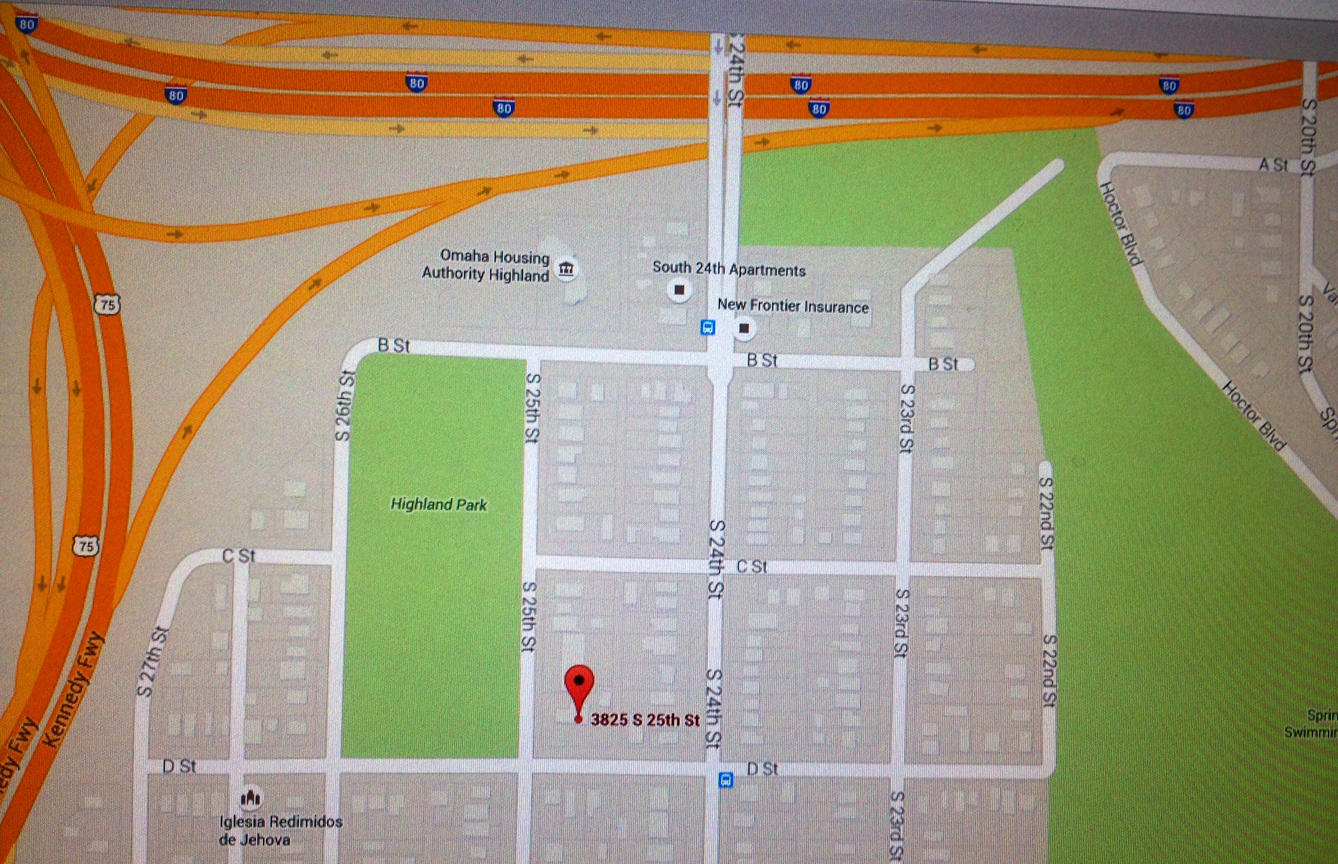
Photo taken from Google map.
Let me start by giving some background information. I had never really known much about South Omaha up to that point. Growing up in Benson, we rarely had much occasion to drive south. I was that kid, like so many, who made a big, dramatic to-do about the Stockyards’ Smell, as we inched ever closer on the interstate. As a child I remember we would travel south infrequently, to eat at Johnny’s Café on South 27th and also to visit Joe Tess Place on South 24th. My parents had met there on a blind date for catfish–a favorite, family story. I do remember playing various South Omaha grade schools in volleyball and basketball where we were customarily met with a fierce pride and boisterous mystique that seemed so foreign to us young Bensonites. Truth be told, those drives south seemed like a whole city away from what I perceived as Omaha. I now know that it truly was its own city previous to 1915. Throughout high school I would begin to frequent the numerous and well-stocked thrift stores in the 24th Street area and there was a short time when Drastic Plastic Record Store called South O home. By then I had a few friends in the music scene that lived south. I knew the, by-then, well-worn path and quite enjoyed it, even though I knew so little of South Omaha’s history.

Photo taken from aerial Google map.
In recollection, I had probably turned off of 24th on one such thrift store venture that day. 3825 South 25th Street. What a find! It was the proper porte-cochere, which beguiled me. I hadn’t seen many of those around in South O. Not only did 3825 impress, it seemed down right intimidating. Self-possessed. It seemed to hold an unusual position on the street—right on the corner of 25th and D. It was both off the beaten path and right out in front, where anyone could find it. The mature trees seemed much older than I was accustomed to and better, somehow. There were some shrubs, which I loved, with rough patches of grass. But where were all of the other mansions? It seemed unusual for a house of this magnitude to be next to a row of common flats. There were some lovely homes in the area but none displaying the haughtiness of 3825, nor inspired that hair-raising quality. It didn’t quite make sense to me.
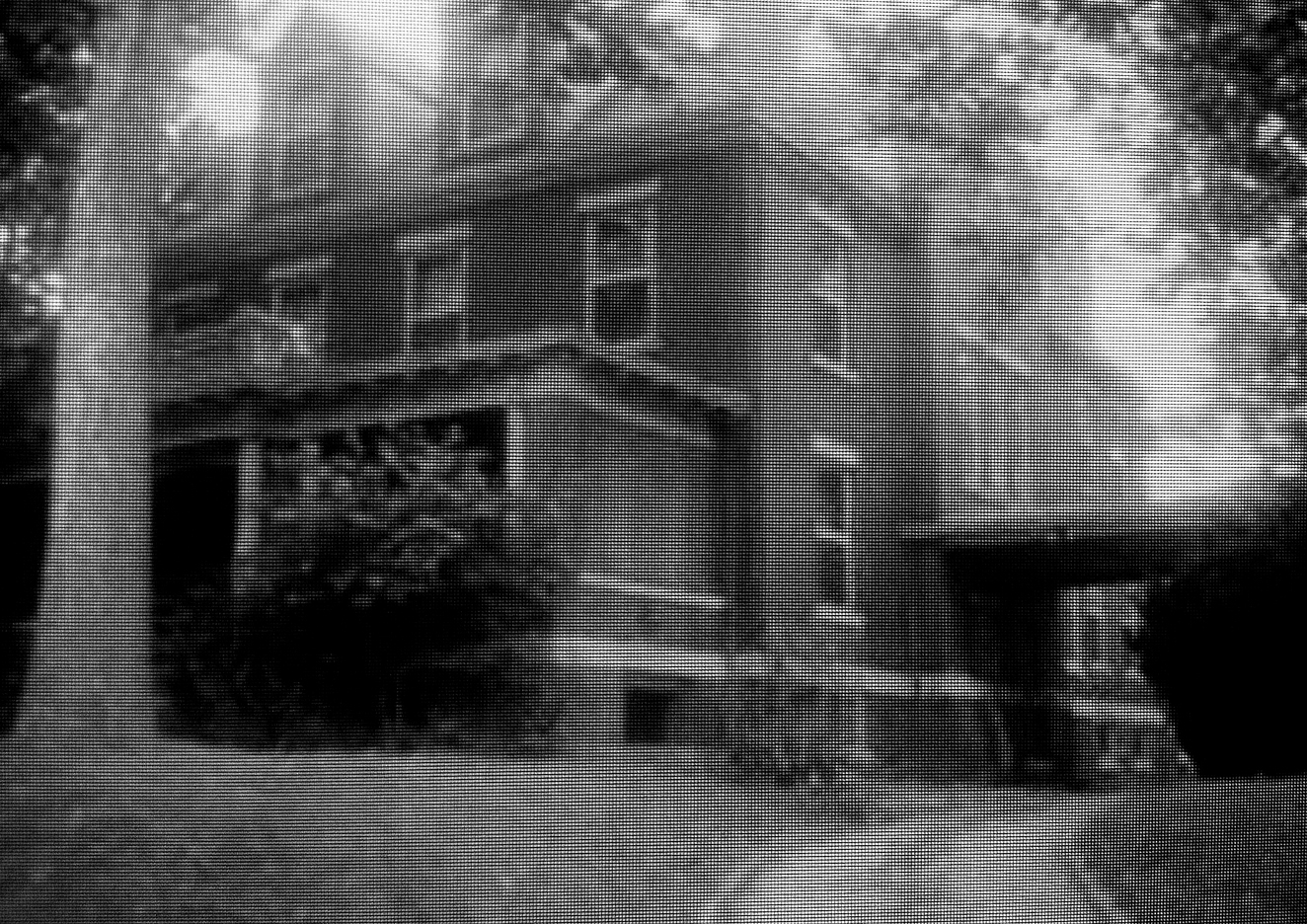
The yard and house were built up, on a bank—imposing, like all elements of the brick home. The windows were tall and gave the impression of staring down at its admirers. Highland Park was directly across the street, having ensured an excellent view for decades. All of this chilling glory, which I admit, I couldn’t resist, stayed with me. A brick estate such as this, especially when it is on a brick paved street, across from a large park, leads to daydreaming and extended, tangled bits of playing pretend house in my mind. I couldn’t imagine the who and the what and the how a person could acquire such a place. 3825, even in those days, seemed worn, in some respects, although still beautiful. I hoped it hadn’t been broken up into apartments. As the years went by, I would stop visiting the mysterious 3825.
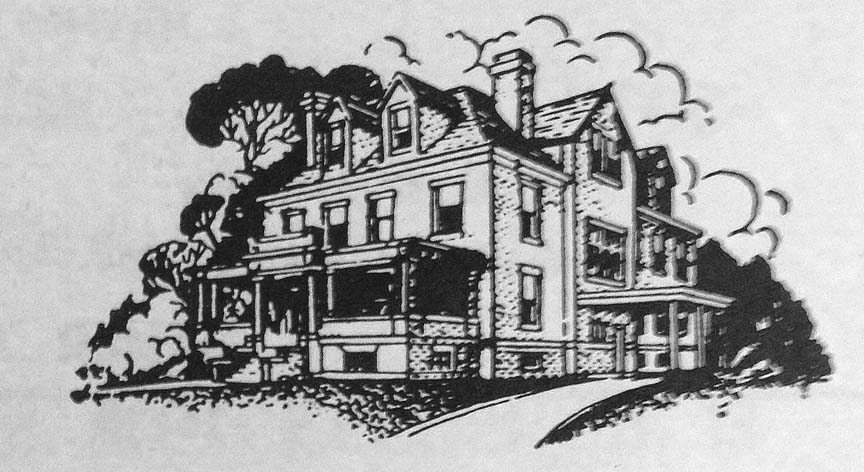
Illustration from an advertisement in the Omaha City Directory.
Recently a My Omaha Obsession reader wrote in inquiring about 3825 South 25th Street, which I recognized immediately. I was absolutely compelled to research this property the moment I wrote her back. I would have no idea of the colorful stories within the house’s walls until just very recently.
Early Fact Finding Mission
I began by spending, what might seem to many people I know, an eccentric amount of time gathering information on 3825. The Douglas County Assessor showed the property being built in 1900. I could find no immediate proof of this. Because of the way different years of the City Directory are represented, some years do not offer a street guide, and some years are blurry, indecipherable photocopies of the original, I didn’t find 3825 listed until 1918. I found the owner’s name listed as “Geo Parks.” George Parks. In years 1923 through 1930, I found “Geo Parks contr” had owned 3825 as well as listed irregularly in different years at nearby addresses 3718-3821. I had a hunch that maybe there had been more large houses originally north of 3825, where the flats now stand. I imagined he was a contractor and might have built or owned other buildings on the block. By 1931, 3825 South 25th Street was listed as “vacant.” The home was listed as “vacant” in 1932 also. I had to find out who this contractor, George Parks, was.
I could not find any information about the original architect nor the builder. The Omaha Planning Department did not have 3825 in their database either. The Nebraska State Historical Society could find no record of the house or George Parks. I would have to go exploring elsewhere.
History of George Parks

In my research, I discovered George Parks, contractor, built the home at 3825 South 25th Street in 1901. In fact the home was so well known and often visited in its day; it was called the George Parks House. This fact has apparently fallen off the books, Until Now. Unbeknownst to me, George Parks was regarded as a one of Omaha-South Omaha’s most important leaders in the late 1800’s. From Omaha: The Gate City and Douglas County Nebraska A Record of Settlement, Organization, Progress and Achievement, written in 1917 by Arthur C. Wakeley, I learned that George Parks occupied a lofty “position among the most prominent and substantial residents of Douglas County.” An immigrant of County Armagh (where he apprenticed in bricklaying and masonry), by way of Chicago, Parks and his wife, Margaret, were brought to Omaha in 1888 to build the Armour-Cudahy packing plant in South Omaha. In 1890 it became simply, Cudahy Packing Company.
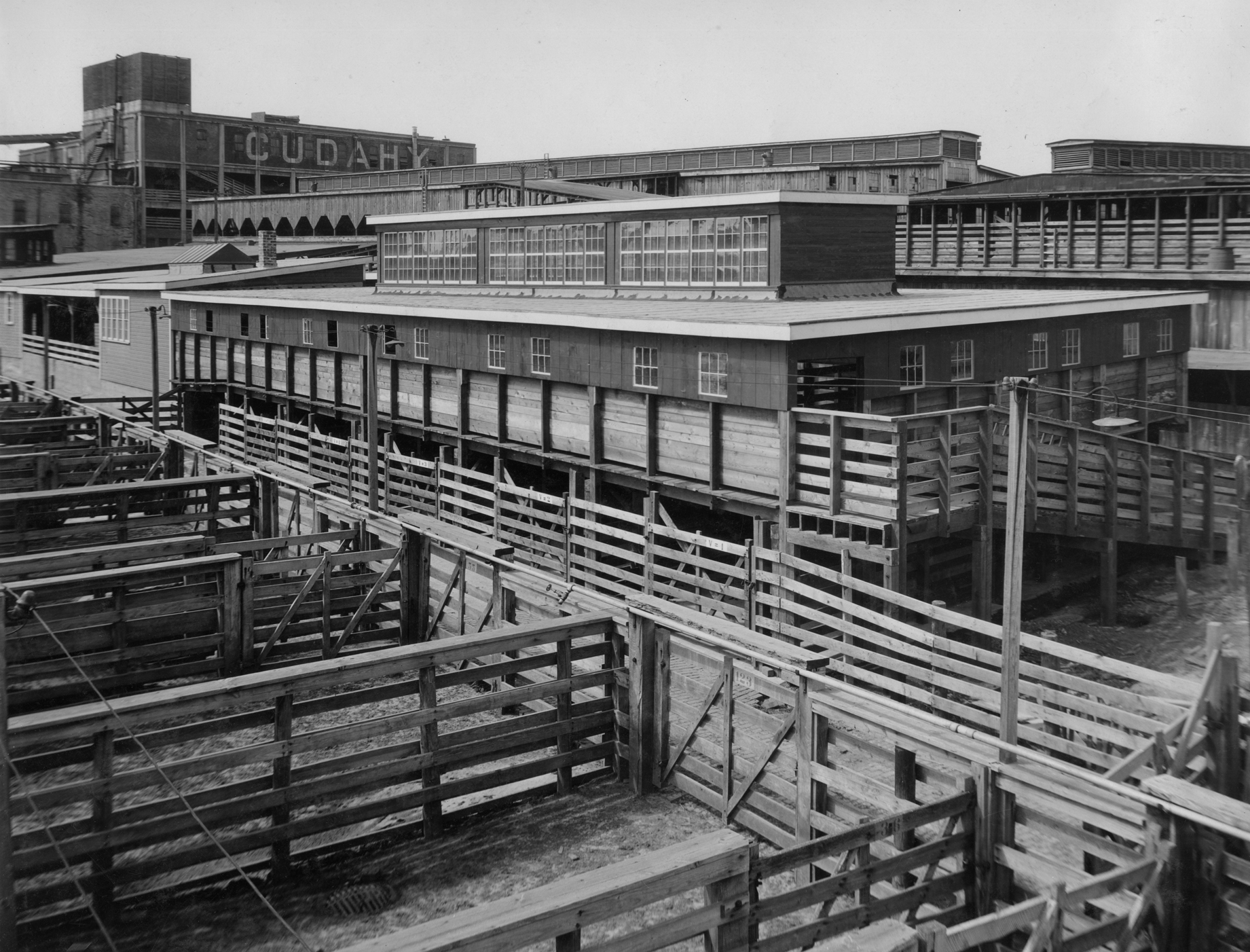
Cudahy Packing Plant. Photo courtesy of Durham Museum Photo Archive.
He spent a full year erecting all the brick and ironwork in connection with the plant. Parks had previously made a name for himself in the construction and bricklaying business in Chicago and was courted by South O’s growing Union Stockyards Company. The stockyards began its long history in 1883 when Wyoming cattle baron, Alexander Hamilton Swan, together with six Omaha businessmen, accumulated the necessary capital and land and formed the Union Stockyards Company of Omaha.

Cudahy’s Packing Plant. 1909. Women packing chipped beef, using wooden work stools.
Aside from being an Irishman, which is tops in my book, my enquiry led me to believe that George Parks was Big Time in Omaha. As president of National Construction Company, George Parks would go on to build, become contractor or subcontractor for every major South Omaha packing plant. According to 100 Years of Omaha Stockyards, by 1910 there were ten slaughtering houses and packing plants located in South Omaha. Parks’ name and expertise won him contracts throughout the United States, where he erected packing plants, hotels, warehouses, train stations, construction of sewers and paving projects. Known for efficient, quality work, he paved most of South Omaha and quite a bit of downtown Omaha, employing many men. Of note, he built the Cudahy Ice House at Seymour Lake and Omaha Wool & Storage Company warehouse—one of its incorporators was Charles H. King, President Gerald Ford’s grandfather.
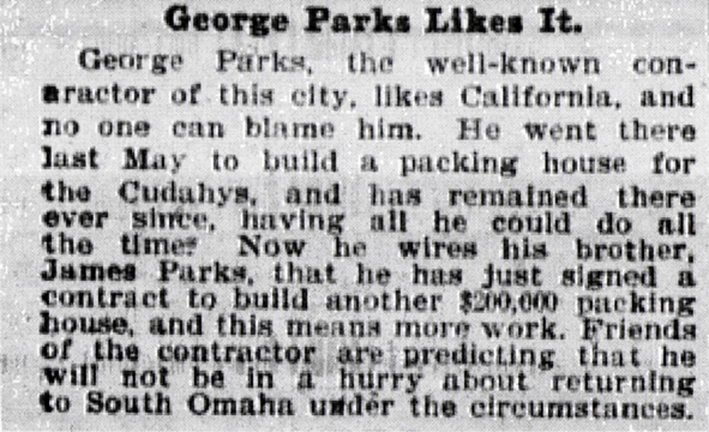
Great little snippet from OWH, February 22, 1905.
George Parks was also president of the George Parks Company of Omaha. It only made sense that in May of 1916, Parks became a city commissioner. As a city official he would further oversee the department of street cleaning and maintenance. He was in numerous men’s fraternal organizations, to include Woodmen of the World. I found so many articles about his service work, as well as men writing into the local papers touting his fine work and character. It was really pretty awe inspiring.
The George Parks House
Is it any wonder that a man so well known for his South Omaha brickwork would create a red brick home in the very place that made him famous? Boasting twenty-five rooms, 3825 South 25th Street was known for its beautiful, steep, pitched roof, stained glass windows with eleven fireplaces. The Parks House cost a whopping $10,000–making it one of the two most expensive houses built that year. Just so we are all on the same page, you must first know that 3825 South 25th Street is a very large house. One source listed it at nine bedrooms and five baths at 7,868 sq ft. Another listed it with nine bedrooms, four and half baths at 6,644 sq ft. Another still listed it with 8,284 sq ft of living space with five and a half baths. If any of these portray a sliver of the truth, 3825 is an immense property.

From the Douglas County Assessor site.
The Parks Apartments
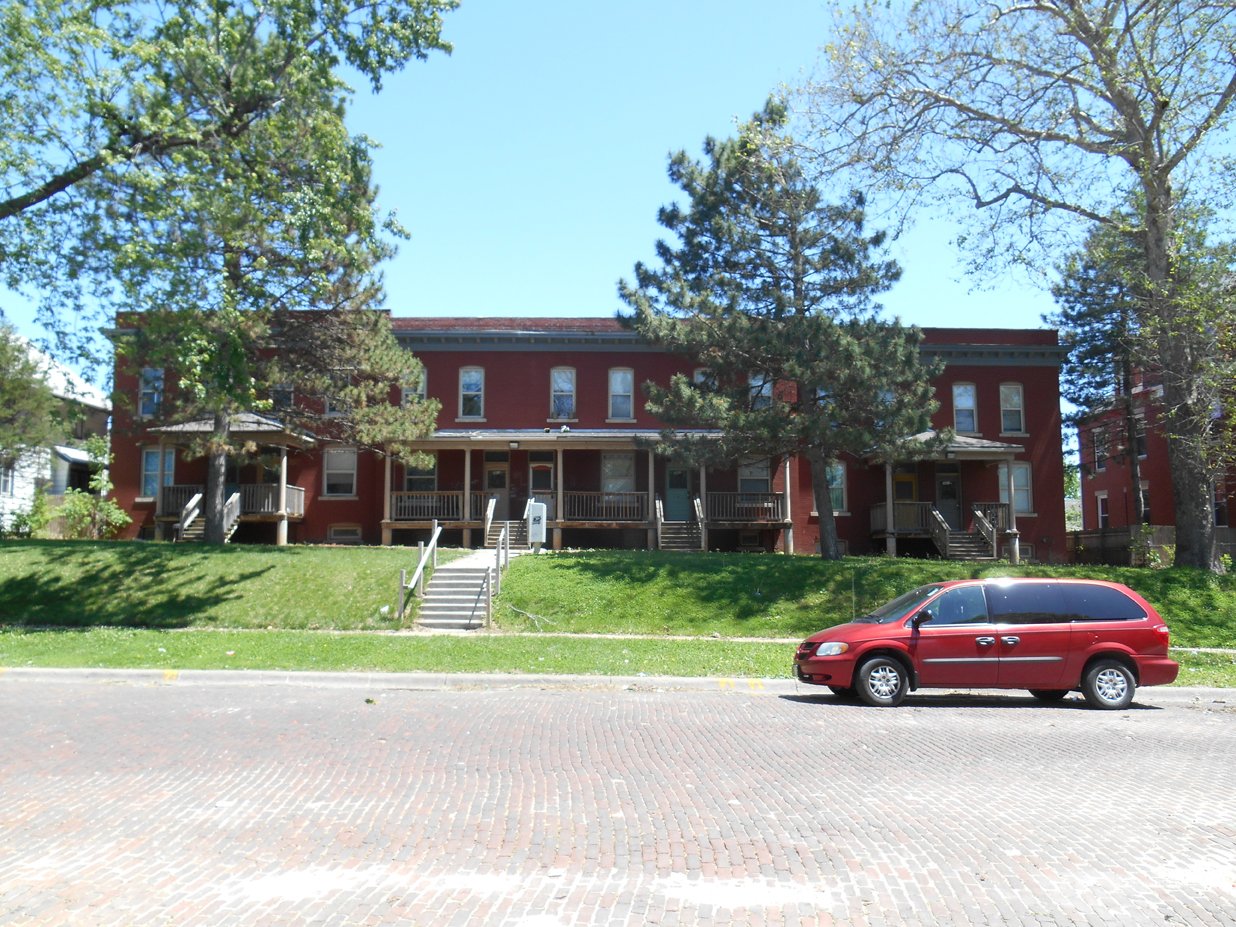
One of the most interesting facts that I stumbled across was learning George Parks also built the row of flats directly to the north of house. (These were the apartments I thought had arrived after some incredible old homes were destroyed.) Constructed in 1901, the same year as his family home, they were known as the Parks Apartments. I was floored. From what I could find, there were 7 separate addresses. In time these were listed as 14 separate apartments. It is possible that these larger apartments were broken up over the years to make room for more renters. It was so fun to see all of the names of renters over the years. As George was known for employing “most of young South Omaha”, I couldn’t help but wonder if he rented to them too? Around this time I came across the brilliant National Register of Historic Places Multiple Property report by Jennifer Honebrink, which clearly described the history of row houses and attached dwellings in Omaha. Fascinating. She reported that from 1890-1930 the rise of the streetcar, a connection to all parts of the city (Dundee, Benson, South Omaha), coincided with the rise of attached dwellings. “A growing number of row houses with more than three units per row” was illustrated by numerous Sanborn maps. By 1918 the rise of attached dwellings had doubled. Throughout the study, it was noted that the row houses were quite adaptable, in that, they could easily change from single-family dwellings into single sex boarding houses, a shop and one even moonlighted as a hospital. I began to understand how the “apartment numbers” of the George Parks flats could have changed and/or doubled over time.

Additionally there was a large carriage house built behind the Parks House in the same year. I would find out more about the carriage house later. Check out G. Wm. Baist’s Real Estate Atlas of 1910, which reveals the house, apartments and carriage house for the first time–thanks to the Omaha Public Library archives. http://digital.omahapubliclibrary.org/earlyomaha/atlas_002.html. I was fascinated to find that Highland Park had always been across the street.
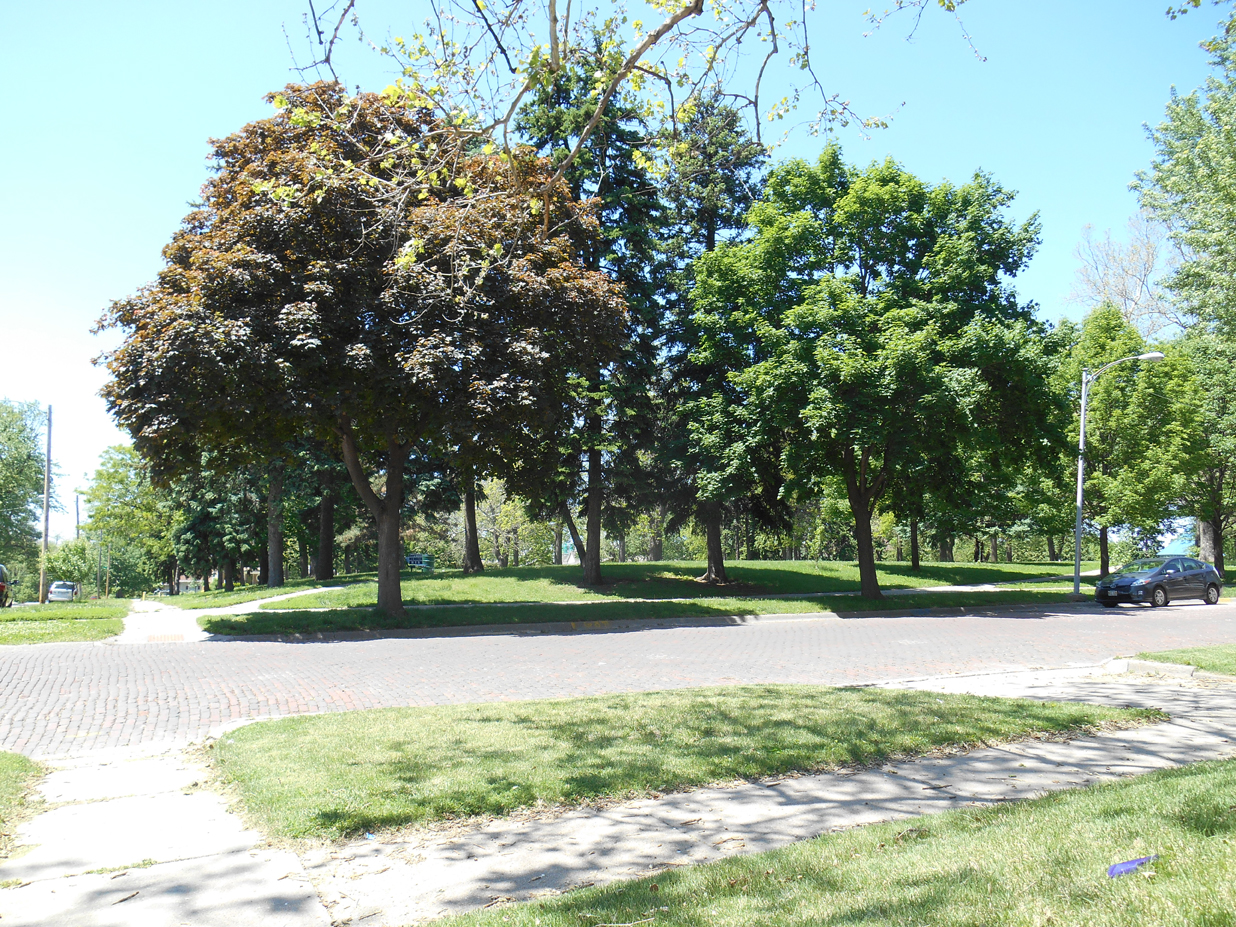 Highland Park, just across the brick paved road.
Highland Park, just across the brick paved road.
The Parks Family
Just as intriguing as their large house and successful lives, George and Margaret Parks also had fourteen children together. Fourteen. From what I found, one of their children, Marie, died in infancy in 1893. All fifteen of the Parks’ family lived at 3825 South 25th Street. After inspecting Ancestry.com, I learned while still living in Chicago, George Parks had sent for his, then widowed, mother, Catherine Hughes Parks. She later died in Omaha in 1911. This tells me that she possibly lived in 3825 as well. And surely they had some servants living in the home. Maybe on that third floor? That must have been quite the lively house. I am not sure if you lived in this manner, but having that many people around sounds like a kind of heaven to me. The more the merrier. Local newspapers credited Margaret with accomplishing social and charitable work while raising 13 children. Her “maternal opinions” were sought after and she was interviewed as a local expert. I should say.
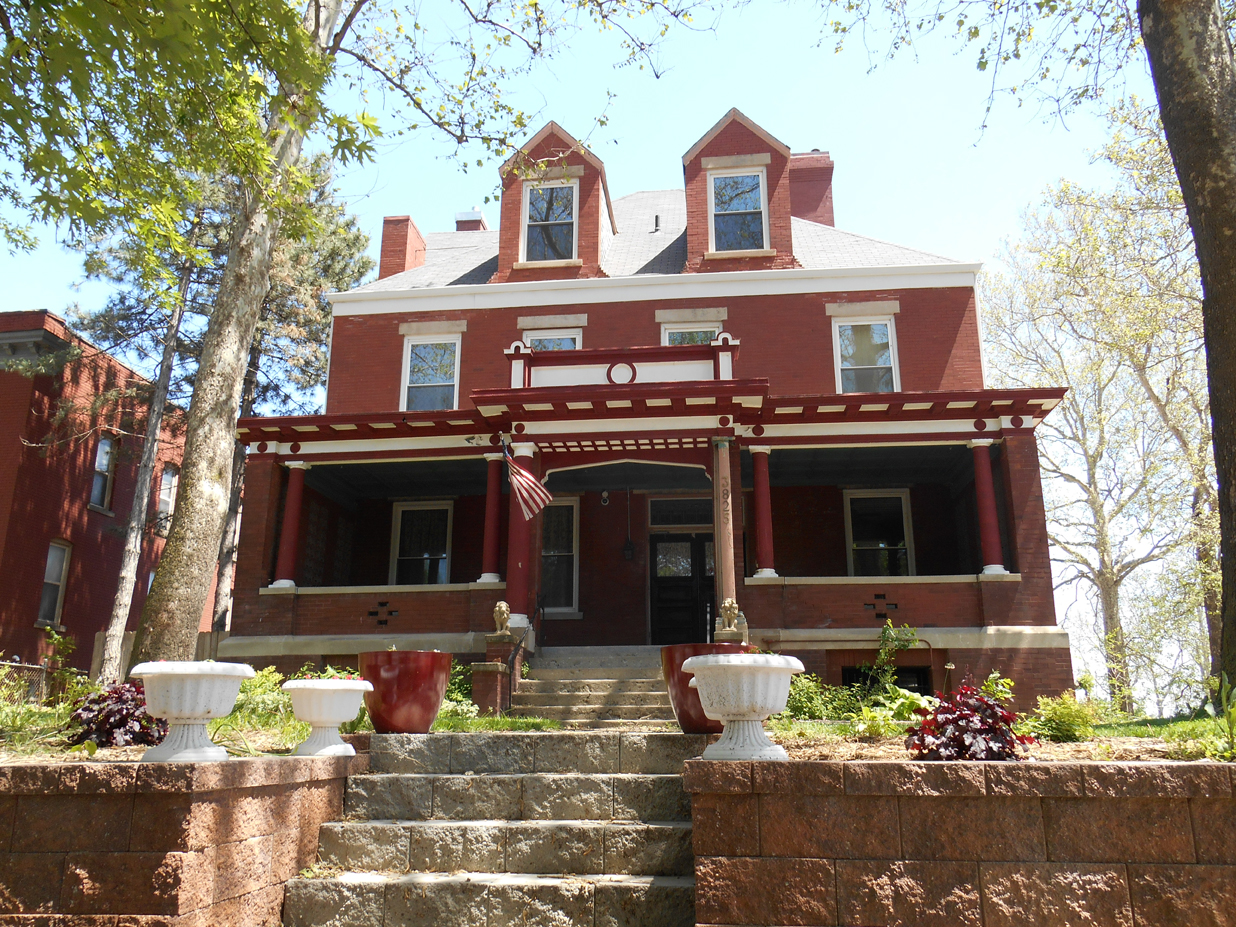
A Social Center of South Omaha

Buffalo Bill Cody
The Parks House had become a true social and political center in both Omaha and South Omaha. I found many newspaper articles citing meetings held at the home over the years. I was delighted to find breadcrumbs leading to Buffalo Bill Cody. He had been an animated guest at the Parks House. George, Margaret and their thirteen children also entertained Irish President Eamon De Valera, U.S. President Woodrow Wilson and William Jennings Bryan over the years. It can be assumed that every big name in Omaha and the region must have been a guest at some point, as the couple loved to socialize and valued community.
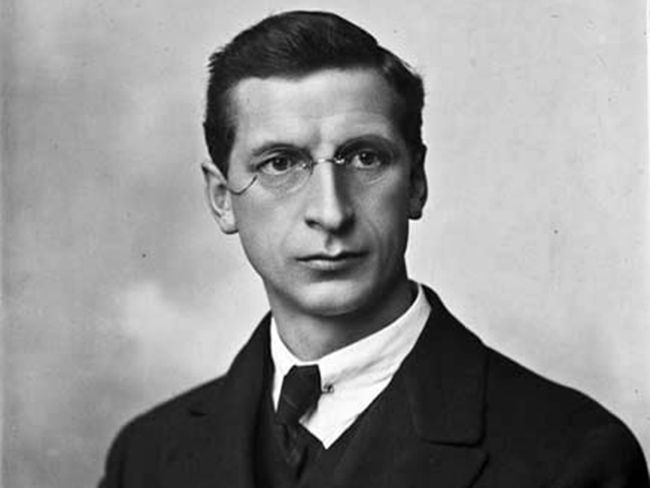
Irish President Eamon De Valera
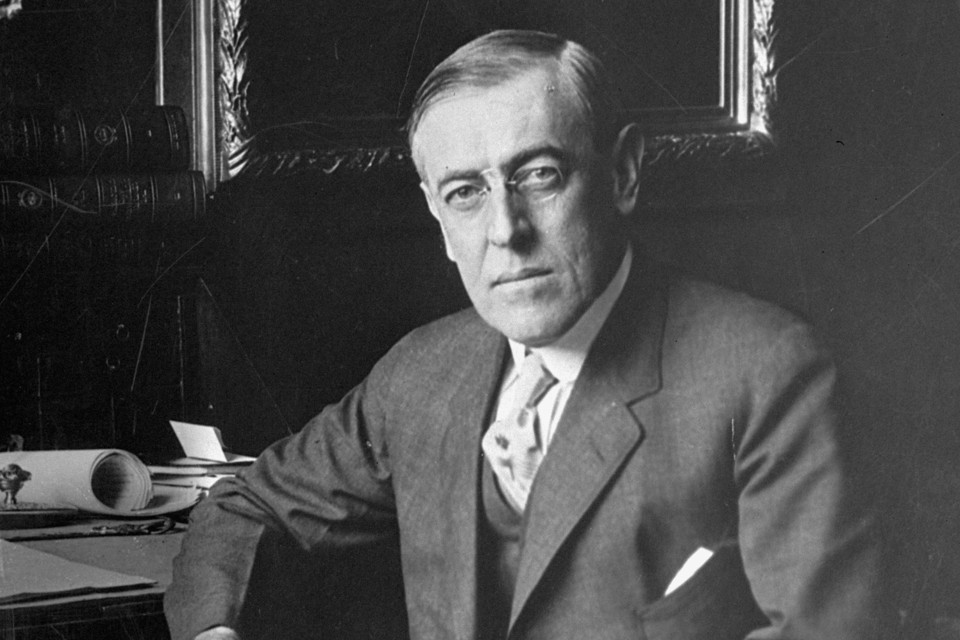
Woodrow Wilson, the 28th U.S. President, poses for a portrait in this undated photo. (AP Photo)
Also discovered were 30th and 40th wedding anniversary articles in the local papers describing incredible parties held in the home. “Such a gathering of intellect and combination of decorative effect has never been witnessed as existed at this wedding anniversary last night.” Described were the dancing, hundreds of guests, “the north half of the home devoted to pleasure” and the large basement arranged with tables “with heaps of good things calculated to satisfy the most epicurean tastes of the guests.” Oh, how divine is that! The full, finished basement was described again in one of their daughter’s wedding reception write-ups. It is interesting to imagine a finished basement of this time period, appropriate for parties of this magnitude.
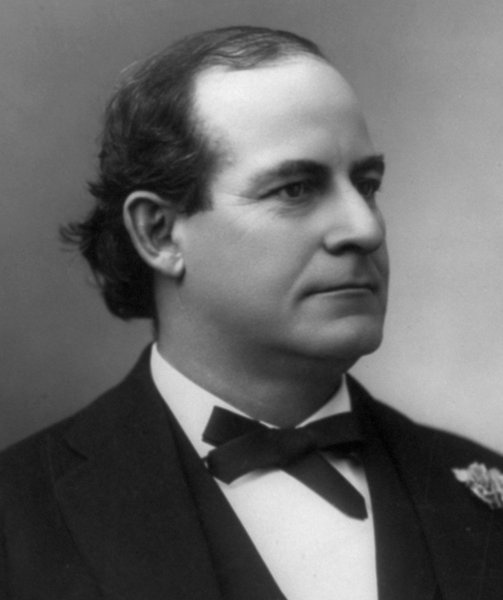
William Jennings Bryan

I am not sure why but it felt too sudden to hear when I came across the news that George Parks died May 2, 1930. He was buried at St. Mary’s Cemetery at 33rd and Q. I am not absolutely certain but I have reason to believe that Margaret died that very same year. In fact, this notice in the Omaha World Herald gives me reason to believe that she might have died previous to George. Oddly, George Parks died without leaving a will.
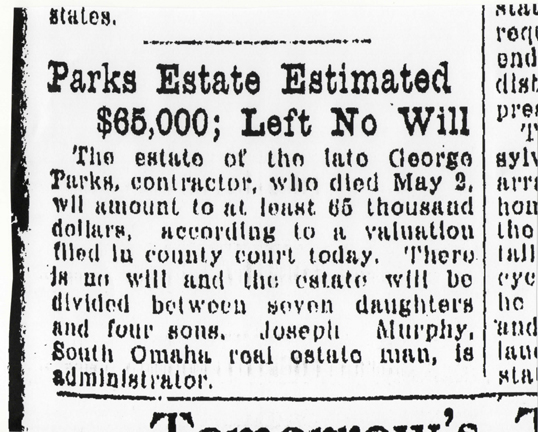
News of Parks’ death from OWH on May 31, 1930.
A Second Life for 3825
The exploration into the history of 3825 South 25th became even more vibrant with the next discovery. I found Heafey and Heafey Inc. took ownership in the 1933 city directory. I had heard a rumor that 3825 had been a funeral home at some point, but reading the news made the pieces fall into place. Heafey and Heafey Mortuary was another long time, respected, pioneer business in Omaha.
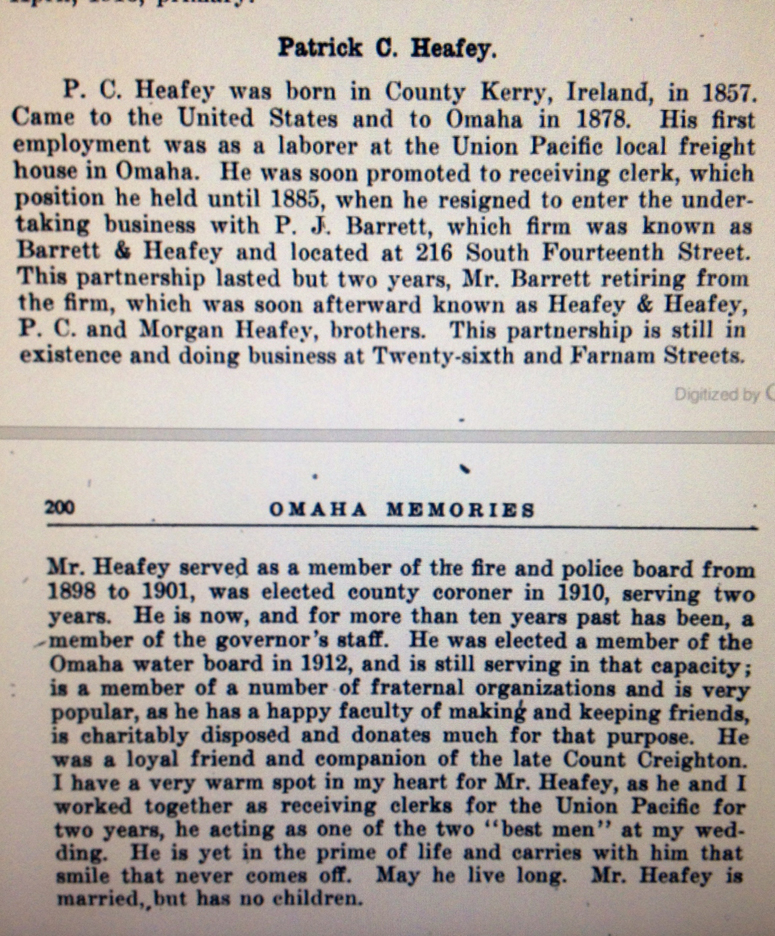
According to Omaha Memories: Recollections of Events, Men and Affairs by Edward Morearty, Patrick C. Heafey was another Irishman, originally from Country Kerry. He arrived in Omaha in 1878. Originally working at Union Pacific Railroad, he left to go into the undertaking business with P.J. Barrett. Together they formed Barrett & Heafey Funeral Home, located at 216 South Fourteenth Street. After Barrett retired, Morgan Heafey, brother of Patrick, entered the business. A new partnership of Heafey & Heafey later moved to 26th and Farnam. Patrick would go on to become a member of the fire and police board, county coroner, governor’s staff, Omaha water board. Patrick was in a number of fraternal organizations and no doubt, had rubbed shoulders with George Parks. Alas, Patrick Heafey passed away in 1921.

Gorgeous tombstone of Patrick Heafey can be found at Holy Sepultre Cemetery on Leavenworth Street.
By 1933 John C. Heafey had become funeral director of Heafey & Heafey. I learned that after the Depression, many families could not afford to maintain their large homes and mansions. Funeral homes began to move into these once privately owned homes. There were many mansions on Farnam Street, now gone, in the Gold Coast District of Omaha that later became funeral homes. (I plan to focus another article, in time, on the long, fascinating history of Farnam Street Mortuaries—stay tuned.) The Parks House had sat empty for almost two full years after the death of George and Margaret. It is understandable that not many people in the early 1930’s would have been able to have afforded and maintained a house such as that.

Here is an article announcing the Heafey & Heafey purchase of 3825 from August 3, 1932, OWH.
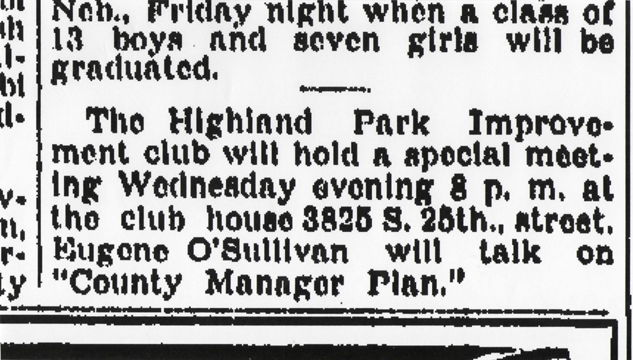
It is strange to me but by May 23, 1934 I found that the Highland Park Improvement Club were holding a “special meeting” at 3825. No mention of the meeting being at a funeral home. I found that odd.
Upon deeper probing in the 1938 city directory, I found that John C. Heafey and family were living in the mortuary. I was completely tingly. Was this possibly as cool and weird as the HBO show, Six Feet Under? I couldn’t believe it. Of course I knew that this used to be fairly common practice, but by today’s standards—shudder to think or absolutely enthralled. You decide. By 1945, John C. Heafey had a small “9” after his name, denoting that this many people lived at 3825. By 1950 there was a “7” after his name. At this point, I knew I had to reach out to Heafey-Heafey-Hoffman-Dworak-Cutler Funeral Chapels to see if I could speak with a relative of John C. Heafey’s.
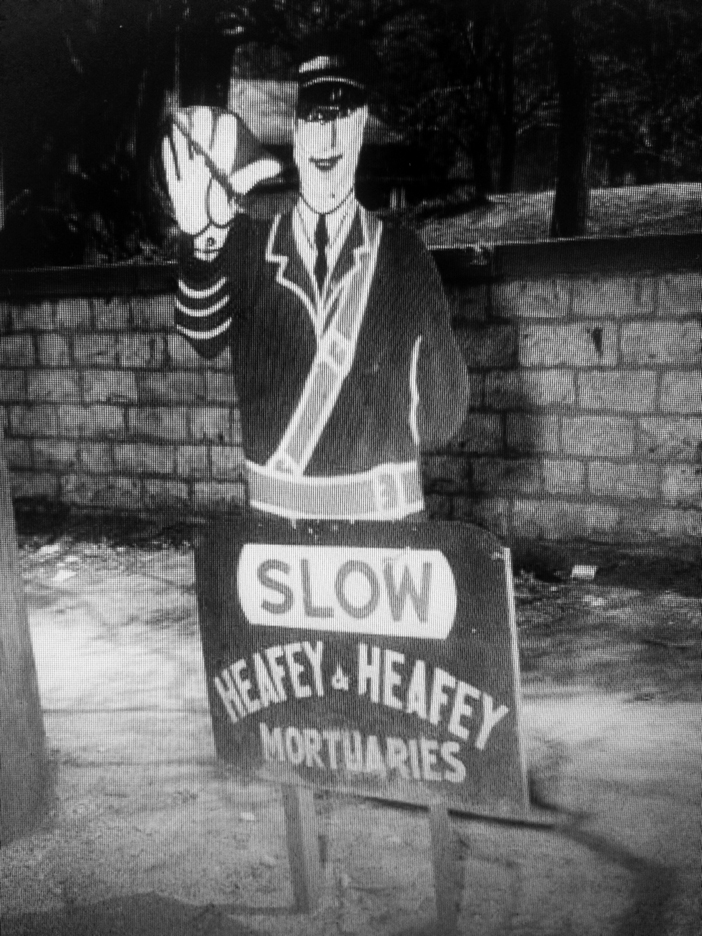
Heafey & Heafey Mortuaries sign. 1950
Tom Heafey Interview
I found Tom Heafey, son of John C. Heafey to be absolutely gracious. What a sport he was to give me his time and share his family memories. According to Tom the Heafey and Heafey Funeral Home started in 1882, where the W. Dale Clark Library is downtown at 14th and Farnam Streets. Later they moved to South 24th street, a site that eventually became the Brown Derby restaurant. He confirmed at his father was John C. Heafey. “We all went to St. Bridget’s nearby and knew the Parks’ from church.” (I later confirmed time and time again that the Parks were long time members of St. Bridget’s.) “My father bought the Parks’ house. They had raised 13 kids in the house!” He also added, “They say Parks used the leftover bricks from his jobs and that built that big, old house.” Another interesting anecdote that Tom shared was “one of the Parks’ daughters was born, raised, had her wedding reception in the basement, rosary, wake and funeral at that very house.” I worked to confirm this information but could not find specific records about this….yet.

Southside view of the house.
“The house was huge! My folks lived in the house on the second floor. There were six bedrooms there. So did my uncle and other employees over the years.” Tom shared that he lived there, as well. When he was older, he lived there with his wife. When I asked him if he raised a family there, he expressed, “That was no place for children. We had moved out by then.” This statement has stayed with me since talking to him because…..wasn’t he raised there as a child?
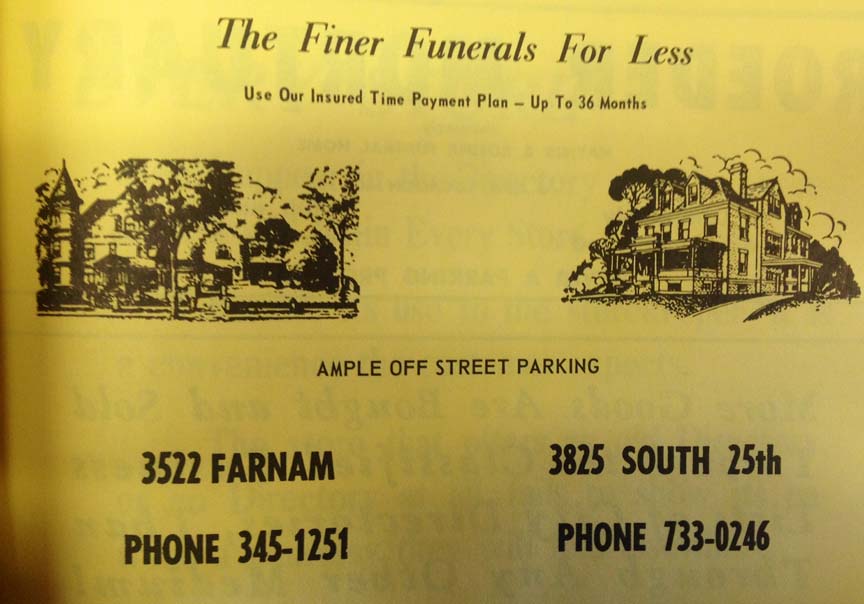
Heafey & Heafey advertisement from the Omaha City Directory.
He explained that many Creighton students lived in the house and carriage house off and on. The main floor was used as a chapel and funeral home visitation rooms. The lower back of the first floor was for embalming and funeral prep. The upper rooms were used as family bedrooms. There was a large recreation room in the basement that was used for family gatherings or funeral luncheons. (These are the glorious rooms described in the press that the Parks used for their large parties.) Funeral home storage was in the basement. I don’t know why but I was totally freaking out at this point.

Carriage House view from the alley side.
Tom remembered 3825 as being “filled with beautiful woodwork. The carriage house was solid oak with tile around the sides. There were two full apartments in the carriage house where mortuary staff or students lived.” Apparently there were numerous stalls for the horses of bygone years with a full turn-table for cars. Miss Cassette didn’t know this, but the early cars had no “reverse.” This meant a car would have to be pushed back out of carriage house-garage when a person wanted to leave. A turn-table allowed the car to be turned in the correct direction to drive out of a carriage house with ease. Mr. Heafey said that the turn-table could not accommodate the larger hearses as the years went by and they no longer used it.

Turntable in Garage
This photo is not from the Heafey & Heafey carriage house turn-table. It is only used to illustrate what a turn-table of that era looked like.
Tom shared another scrumptious detail. There is a full basement in the carriage house and there is or was a tunnel connecting that carriage house basement to the mansion. I found that this was a common trend in mansions with carriage houses at this time period. Very forward thinking when a person considers our weather here in Nebraska. Also my beautiful porte-cochere, previously mentioned, lent itself nicely to the funeral home–a proper detail when letting a mourning family in and out of a hearse. I began imagining what life would be like growing up in a mortuary. Living where you work would be odd enough, in that, your private life is probably shadowed away from view. But a funeral home, for Pete’s sake? It was probably considered bad form to leave one’s bike on the lawn.

On that note, I found in the January 8, 1973 Omaha World Herald that a daughter was born to Ben and Debbie Funk of 3825 South 25th Street. Perhaps they were Heafey & Heafey employees or some of the students that Tom had mentioned.
Funeral Home Enquiry
By 1975 I had unearthed an interesting change in the directory. 3809 through 3821, previously the Parks Apartments, were listed under the San Francisco Apartments. Additionally James B. Heafey was listed as living at 3825, no longer John C. I found that John C. Heafey passed away in 1972. He is buried at Holy Sepulchre Cemetery also. I am not entirely sure that James B. is the uncle Tom spoke of.

Photo of John C. Heafey’s headstone.
Tiptoeing through the Omaha Obits site, I learned further history about the timeline of Heafey & Heafey. Heafey and Heafey Funeral Homes operated both 3552 Farnam Street and 3825 South 25th Street from 1930 through the 1960’s. By the 1980’s they had the one location at 3825 South 25th.
The funeral industry would go through another shift in the 1980’s when funeral home corporations began buying up the small, family owned mortuaries. Heafey and Heafey survived this time, and continue to flourish to this day, by joining with other private, locally owned mortuary businesses. In 1982 Heafey-Heafey & Hoffman Mortuaries joined forces. They maintained three locations during this period at 7805 W. Center Rd., 24th & Dodge St., and 3825 S. 25th. According to the Omaha World Herald, funeral director, Leo A. Hoffman, died in 1984.
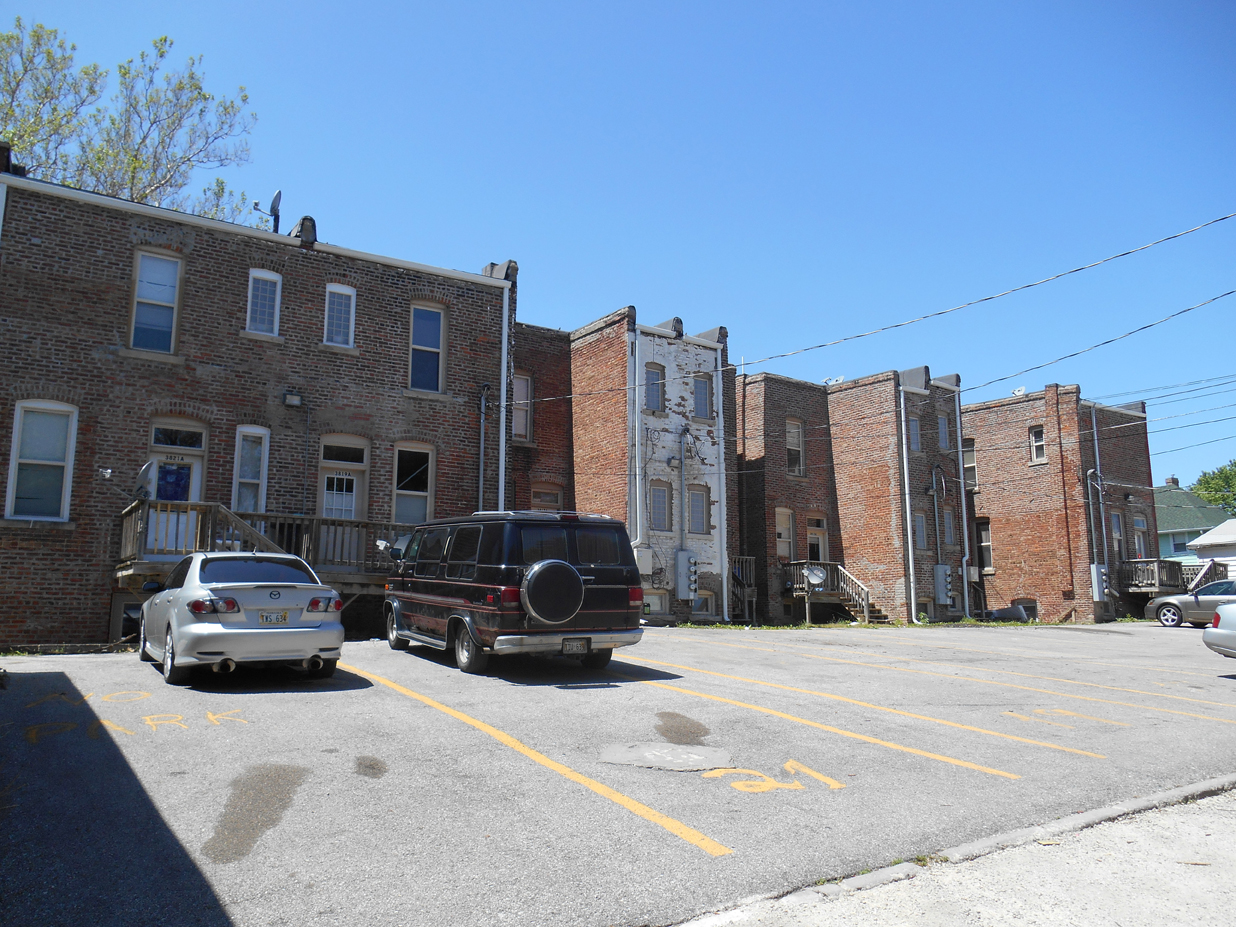
Eastern (back) side of the row houses.
1987 brought another name change or ownership change of hands. The San Francisco Apartments became the Towne Center Apartments. There continued to be seven different apartment listings all under that name.
In 1990 there was yet another funeral home merger, becoming Heafey-Heafey-Hoffman-Dworak-Cutler Funeral Chapels. This new, larger mortuary had three locations at 7805 W. Center Rd., 24th & Dodge St., 3825 S. 25th, and 2466 S. 16th St. 1990 is also the last date I found the funeral home listed at 3825.
Perplexing Chapter in the History of 3825
There are a number of points going forward that I am doubtful of and am going to attempt to lay out for your inspection. Either I need to do more digging in these areas to get the chronological order correct or the history of the house, at this particular time, was truly this confusing. Confusing point number one: Tom Heafey stated that at some juncture, the “Landmark Preservation group” approached them about wanting 3825. “They were just getting started and they wanted the house. They wanted it in a form of a donation and I just couldn’t do that.” Tom said Heafey-Heafey-Hoffman-Dworak-Cutler wanted out of 3825 simply because of the times. “The trend is always to move west. From our beginnings on 14th and Farnam. Always west.” They were not able to donate the house to the new Landmark but I think we can assume that the funeral home was looking for a buyer long before 1990 by the following perplexing pieces of the puzzle.
Confusing point number two: A World Herald article that I found from August 2, 1979, summarized United Catholic Social Services had intentions to buy 3825 South 25th St. Their idea was to “house up to 20 youths who have undergone treatment for alcoholism or chemical dependency.” Apparently the idea was that 14-19 year olds would remain in the home for four to six months, I assumed, like a halfway house. The neighbors balked, taking issue with safety. Oddly the article referred to 3825 as a “former mortuary.” But by all other accounts, Heafey-Heafey in all of its stages, were operating out of 3825 until 1990. I began to wonder if they owned the building that whole time, but had moved their business long before? Perhaps like the Parks’ estate, finding a buyer for 3825 proved difficult? I could understand the barrier in that it was a very large estate and now it had the stigma of having been a mortuary for decades.
Confusing point number three: According the Omaha World Herald article from September 12, 1979, the permit was granted for the United Catholic Social Services group care home. “Four residents of the area opposed the plan, saying it was inappropriate for the area.” I maintain that this point has continued to confound me. James B. Heafey was living at 3825 in 1979, according to all accounts, as well as running the mortuary from this site. I began to wonder if the Highland neighbors fought this to such an extent that the group home never came to pass. In which case the Heafey & Heafey family was still carrying the ownership. I could find no proof that the group home ever took ownership or got off the ground on 25th.
More Clues and Even More Questions
Things began to get back on track for me when I found a real estate transfer from January 31 of 1993. Thomas P. Heafey to Gregory T. Nelson for $50,000. This piece fits nicely with a comment that Tom Heafey made near the end of our talk. He said, “A couple bought it and wanted to start a bed and breakfast. They never did. I never heard what happened with that.” Additionally I found in the city directory of 1995 that Greg Nelson and Holly Winters owned the home. I figured they were the couple that wanted to start the B and B. Can you imagine the marketing of a funeral home turned guest inn? Now that would have been fabulous.
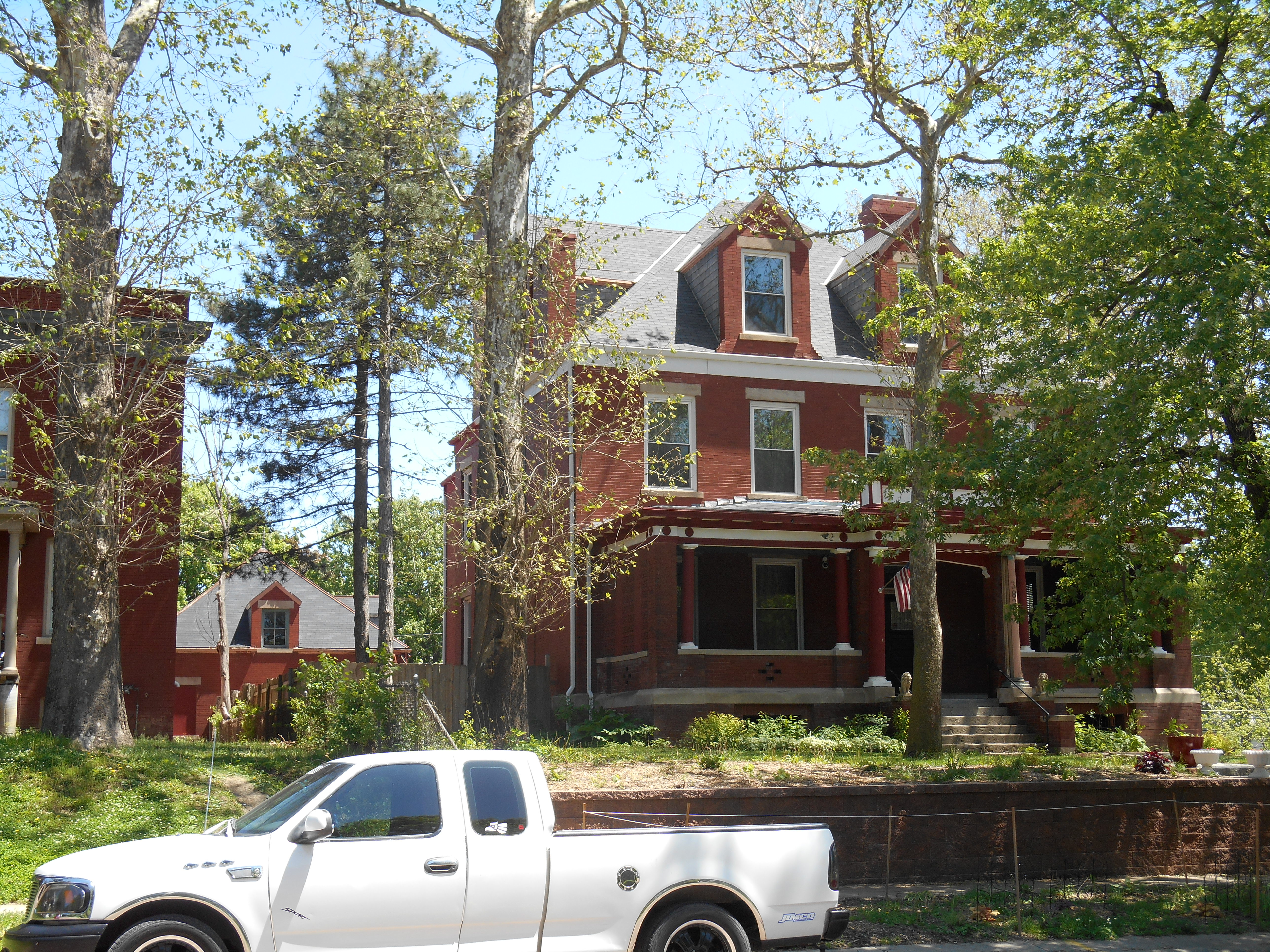
This view from 25th allows you to see all three buildings in relation to one another.
According to my findings, in October 15, 1995 there was another real estate transfer listed from Gregory T. Nelson to Richard L. Larson for $135,000. Within two years the couple had likely made some nice improvements adding value to the home but had decided to move on. I did not know why. The 1998 city directory showed that R. M. Suiter and Richard Larson were living in 3825. Again in May of 1999, another real estate transfer was filed from Richard Larson to Richard J. Larson for $124,000. The city directory of 2003 showed Image Ad Specialties (advertising and promotional co.) to have taken over ownership. Additional names of Roxanne Suiter and Dorothy Suiter were listed under this title. I was pretty sure that these people had a connection with previously mentioned R. M. Suiter from 1998.

I found 3825 South 25th St was listed as part of the 2005 Reconnaissance Survey of Portions of South Omaha. In this survey, the home was one of seventeen individual properties identified as good candidates for designation as an Omaha Landmark and an appropriate future listing in the National Register. I was overjoyed.
Later, after corresponding with Trina Westman of Urban Design and Historic Preservation at Omaha Planning, I learned that 3825 South 25th Street was surveyed as part of the 1980 Landmarks Inc. Survey. She kindly included three photos from that survey. They are Incredible.

1980 Survey. Photo used with permission by the Omaha Planning Department. Notice the great Heafey & Heafey sign out front.
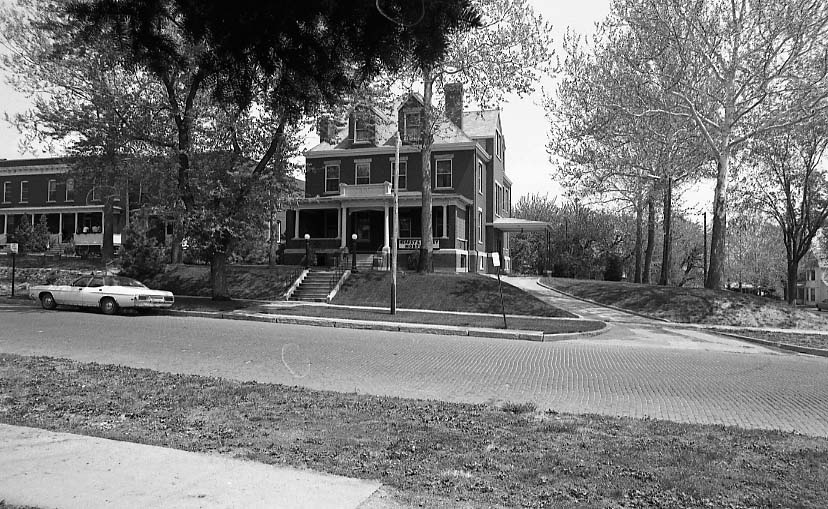
1980 Survey. Photo used with permission by the Omaha Planning Department.
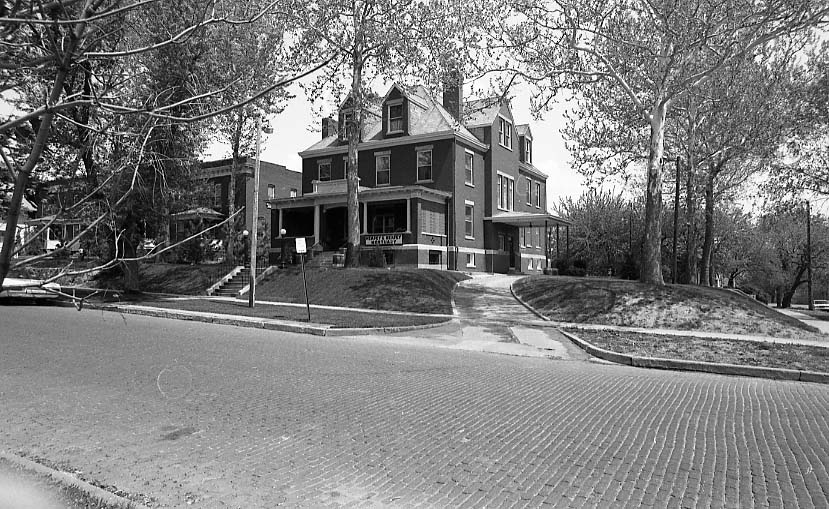
1980 Survey. Photo used with permission by the Omaha Planning Department. My favorite one.
Trina also included the information gathered from page 68 of the Landmarks Inc Survey. This document shows information about building additions or alterations to 3825 in 1937 and 1972. After all of my obsessive digging, we now know who the original builder is and that was valuable to me. 1980document
Mysterious Turn of Events
Mysteriously, 2009 found Richard Larson Jr. listed as owner of the house again. Perhaps he was partner in Image Ad Specialties. I have reason to believe that Richard J. Larson then sold, lost or was losing the house to foreclosure in 2010. Sadly he passed away in December of 2010. I am not sure what the cause of his death was, only that he was a young man, at 55 years of age. What is known for sure is that at some point in 2011, 3825 South 25th Street, unfortunately, fell into foreclosure. This is where things got a little more peculiar.

Miss Cassette happens to know a wide variety of people and being brave in nature, is not afraid to call upon contacts if it means rooting out an investigation. I knew I would have to get dirty and call up a contact in the foreclosure business. A secondary cleaning company or a foreclosure clean out company is another party involved in the foreclosure process. Often the bank or another entity will hire a sweep out crew to come in and clean, organize and empty a home after the last owners have moved out or been locked out by the bank. Part of cleaning out a foreclosed property entails photographing the condition that the house was prior to entrance, documenting all work done and taking “post” photos to show condition. The following are not their work photos but rather when the house was on the market again.

The Cleaning Team Interviews
In talking to the foreclosure clean out crew of 3825 South 25th, I learned many, many things. Some memories are still bothersome to those who helped the clean out that summer. One member of the crew, when asked why the house might have been in foreclosure, thought “A man had bought it for his wife and she died suddenly. He was left with all that house and no money.” She remembered the house was filled with antiques and “it was like he moved what he could with the limited time he had. He left the rest of the furniture.” The house was in a worn down condition but the team was awestruck by the sheer size and obvious once glory of the estate.

Apparently there were a couple of big rooms in the basement, which looked “updated”. One looked to be an office-type space, and the other side, they perceived to be storage space for the funeral home items. “As you walked toward the other end of the basement it got creepy where the outside door came down into the basement. I assume this was the entrance for bringing bodies down for embalming. There was a large concrete room. There was a large furnace or maybe it was a cremation stove. There was another room you could access by walking through this room. This where there was still a long narrow table in it but we only had our camera flashlights so we didn’t spent a lot of time exploring this. It was moldy, smelly and cold. Off the initial concrete room were about four to five small narrow stairs that went down even further than the basement into a cellar like room.” There were shelves there but nothing in the room other than rusted cans of what they believed were embalming powders or fluids.
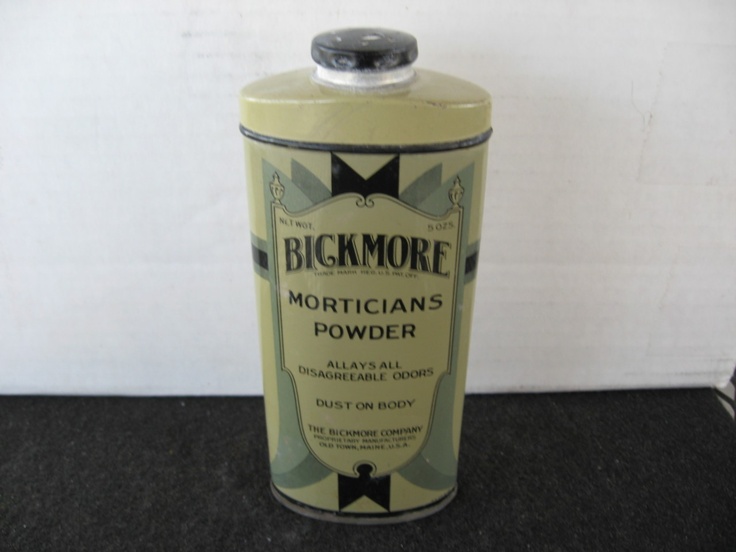
This photo is not from that day but the cans in storage were shaped and looked like this. Miss Cassette began to wonder, were these cans left over from the funeral home days, similar to a homeowner of the past leaves clues for homeowners of the future? Mr. Cassette and I found a storage area in our early 1940’s home that was filled with leftover linoleum, old tiles, extra paint, fantastic 1940’s metal blinds, wood trim, bags of original hardware and a square of old carpet—but nothing like this. Apparently that was not the only thing left. The mold was so bad that they had to wear masks because they could hardly breathe on their own.
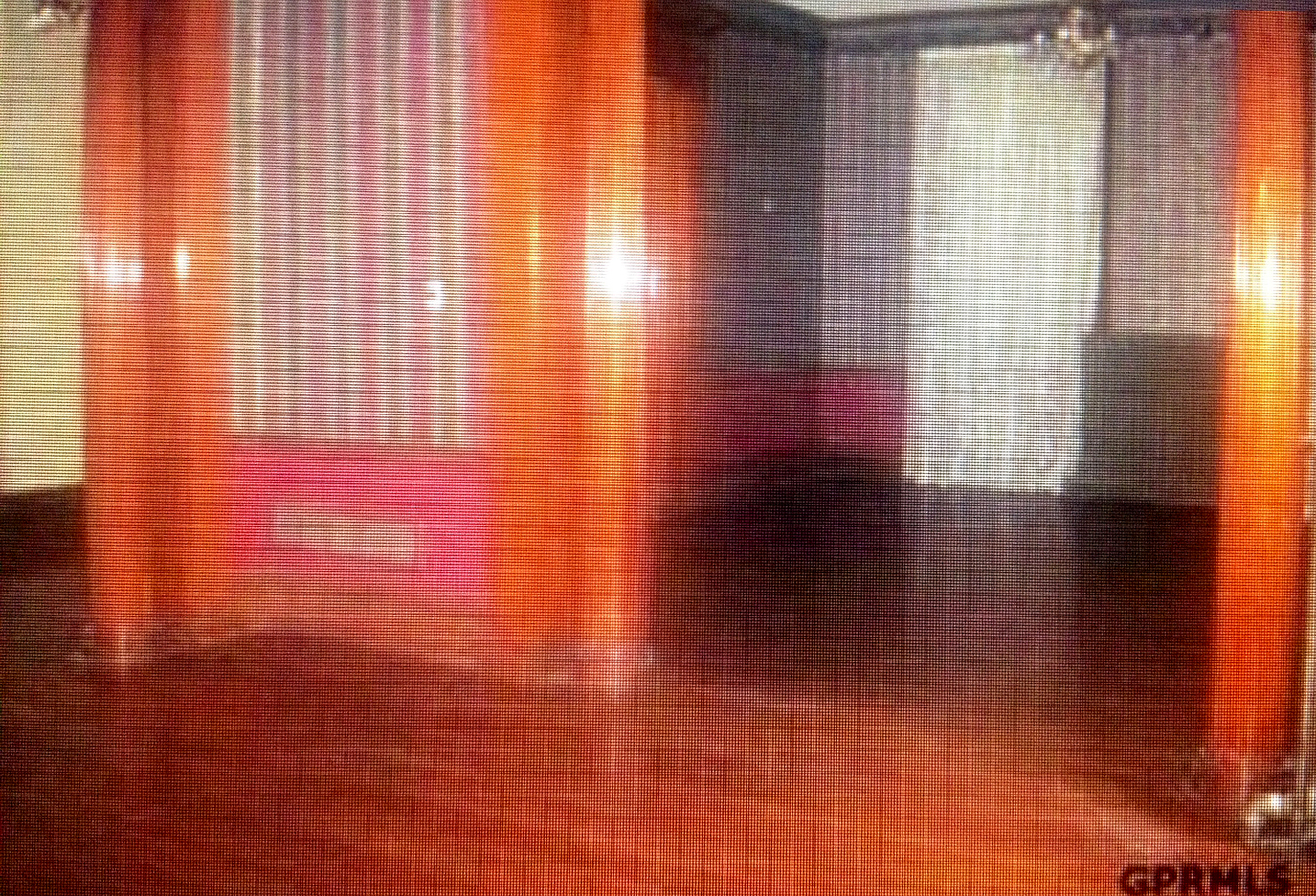
One member of the cleaning company was working at the site alone one day—the only person with access to the property. She had just finished cleaning one of the renovated bathrooms on an upper floor and had moved into another area of the home. As she was coming back through the house, she observed a small, lit candle found flickering on the edge of the Jacuzzi tub she had just cleaned. This was terrifying to the worker as she did not remember there being a candle in the bathroom at all nor did she light the candle. After that experience, she had other workers accompany her to the large property.

Another of the cleaning staff reported on a different day, “I placed a camera on the kitchen counter and we all went up to the third floor to work. When we came back down, the camera was on the floor on the other side of the kitchen with the batteries out—like it was thrown across the room.” All three cleaning crewmembers agree, “Just creepy feelings in general the moment you walk in there. Not a good feeling.”


Newest Chapter for 3825
**At this point, out respect of those personally involved, I am going to omit the owners’ names. This has come up in the past as an issue of privacy and I certainly want to be sensitive to all involved.** My research again led me to another real estate transfer in the summer of 2012 from Mr. M to Ms. A for $95,000. I am not sure if Ms. A is part of a local investments company but at some point 3825 South 25th Street went on the books under the name of I. Investments LLC. I. Investments continue to operate their business and the management of their many properties out of 3825. Most likely Mr. C, principal employer lives there and possibly others live there, as well.
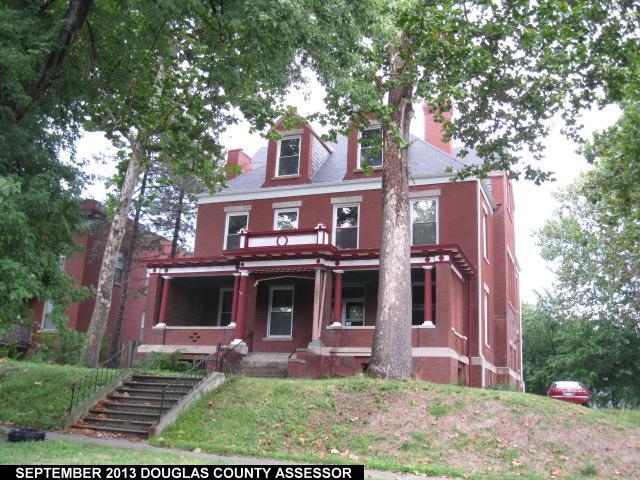
Assessor’s photo. Must improvement has been made to the landscaping since this photo was taken.
I knew I had to call the police just to be sure I beat the bushes. From the Omaha Police Department records department, I learned that the OPD received a “destruction of property” call in 2015. Upon OPD arrival, the owner claimed that someone (unknown to this day) had apparently thrown a brick through the large, glass plated front door. Ironic. The vandal reportedly “ran toward the Highland Towers.” The Highland Tower is a few blocks north of 3825. I could find no other crimes associated with this property.
Incidentally the Parks Apartments are currently owned by 3809 South 25th Street LLC c/o the Omaha Group LLC, an investment group out of Denver Colorado. They purchased the historic row houses in 2015. The flats are again listed as 14 units.

Garden on the south side of the estate.
I honestly don’t know how I managed to walk so jauntily down 25th Street, after hearing what I had been told by the cleaning crew. I knew I had to get photos though. My only thought when my mind ventured to chilling places or fear on that walk around the property was that I hoped a spirit or spirits would understand my intention. An odd hope that there could be a mutual understanding. My eye was drawn upward to the truly spectacular property. Where was my porte-cochere? I couldn’t believe it was missing. It was still intact in the photos taken during the foreclosure sale. I was saddened. After many years of neglect due to changing of owners (and who has that much money, after all?), in the years post Heafey & Heafey, has altered the old girl’s character. I can see that the new owners are working or were working to bring her back. She retains an individual pride and beauty. Great interest has been shown in the garden surrounding the property and there were telltale signs that someone is there frequently. It may seem childish but as I walked down the brick road to my car, I hoped that the house and all inside, whatever shape or form, knew it was an treasured part of Omaha history.
This story now has a second part. Please read up on Mysteries of Omaha: 3825 South 25th Street Part Two when you can.
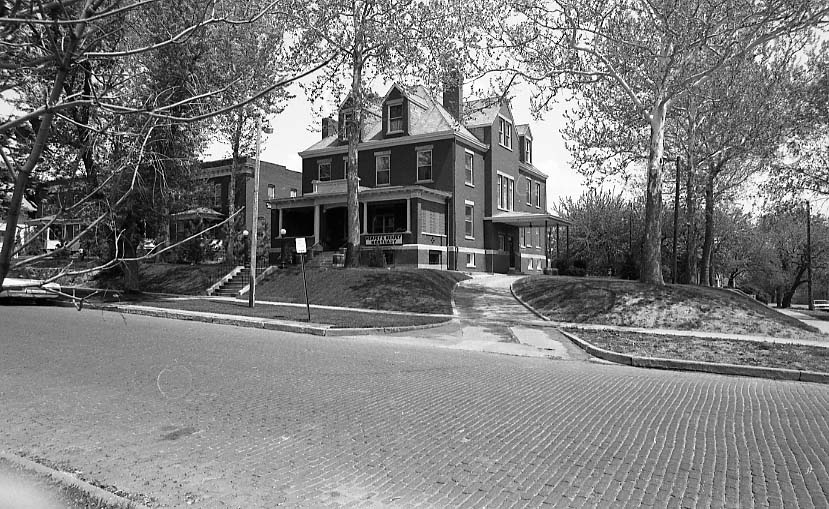
Thank you for reading my blog. I have had so much fun researching and writing this story. I would love to hear from you. To comment or read others’ comments, please click on the article title. If you would like to email me privately please do so at myomahaobsession@yahoo.com. Thank you, Omaha friends.
© Miss Cassette and myomahaobsession, 2016. Unauthorized use and/or duplication of this material without express and written permission from this site’s author and/or owner is strictly prohibited. Excerpts and links may be used, provided that full and clear credit is given to Miss Cassette and myomahaobsession with appropriate and specific direction to the original content.
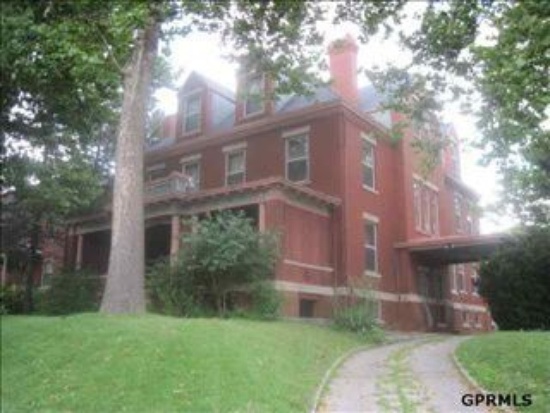
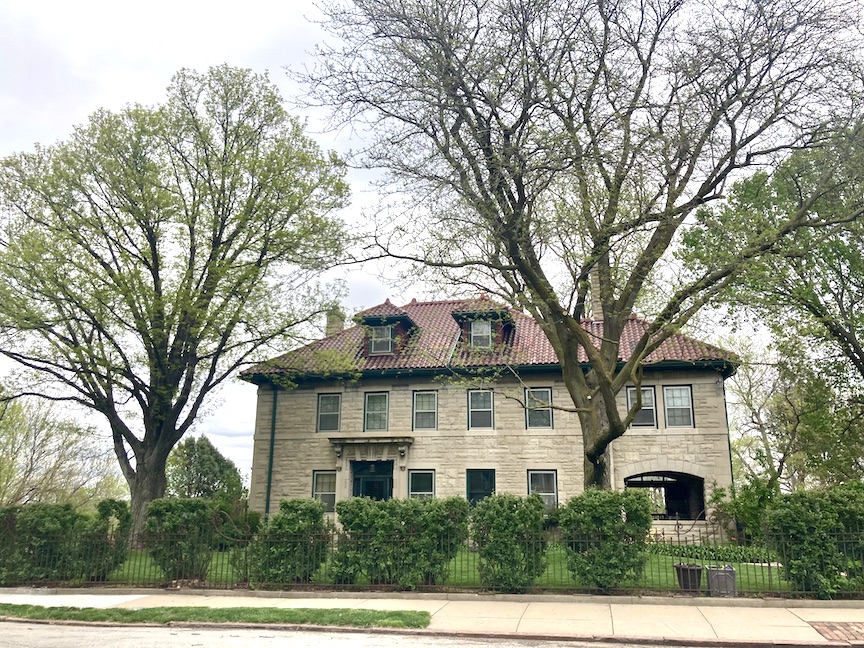
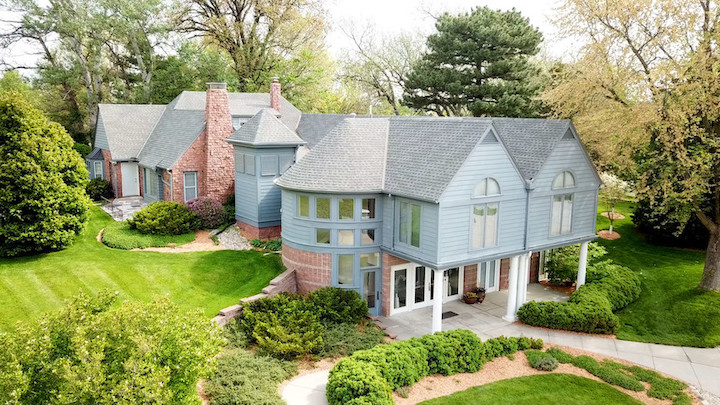
George parks is my great grandfather
Sent from my iPad
>
What a well liked, well respected man your great grandfather was. I only wish I had more time to scan the many articles I found about him. Thank you for sharing this news.
Mine too my grandmother was his daughter Cecile. It’s a sad story but I am very proud of him ❤️
One of the best, Miss Cassette. I got the creeps reading about the spooky moves during the clean-up.
Thank you!!
When this house was in foreclosure 2011/2012, I considered purchasing the home. I fell in love with it immediately. I only wished I had the money to restore the home to its deserved glory. This being said your research is very similar to what I found. In a closet on the second, there was an area that had never been painted over with a first initial and the Parks name with a year. This started my hunt into the home (I am going to have to see if I can find that photo for you). The woodwork in the home is amazing. Neat story about a home with history!
Wow! Yes, find that photo when you can. I cannot imagine the cost of rehabbing, let alone maintenance and utilities of an estate such as this. Thanks for your comment.
I have lived behind this house for 23 years. I love this house! Wanted to buy it but was told I need a contractors license to purchase the property. Would have been a lot of space for one person.. LOL thanks for your hard work on this. Was fun reading.
Now That is very interesting. A contractor’s license, eh? I will inquire about this. I’m sure you daydreamed about what you would do with the place. How cool. Thank you for your comment.
A friend thought that if the city had condemned it or it was in very rough shape, they might have stepped in w that licensing requirement. Such a large job for the regular Jane to take on.
This wonderful home is just 2 blocks from my house at 3705 S 25 St.
Great article to learn so much about this property.
What a great part of town. You are so lucky. Another reader just tipped me off to a great house for sale in this area, but east. I’m looking into the case! Thanks for your comment
Thank you for all your research on this property. I love hearing about old stories like this one. I honestly do not recognize the neighborhood, but my husband does since he had worked for the City of Omaha Parks department for some years and is familiar with out of the norm parts of south Omaha. It has been an interesting read for a Sunday morning! Thank you for all your wonderful work documenting this property. BTW – Tom Heafey and Leo Hoffman were old friends of my dad. Tom Heafey is the mortician I have contacted for many family funerals as I have helped with those who have gone before us! Had no idea of this property ever being park of the Heafey/Hoffman history! Thank you. Have you considered putting this information in a book form for sale? If so I would love a printed copy to add to my many history book about Omaha!
Oh thank you for your comments! I really appreciate it. You will have to swing by sometime. Yes, I would love to have a book someday. I hope that can happen. Thank you!
Thank you for your research and sharing it! I have to drive by it now. I also grew up in Benson had the same opinion of South Omaha until I grew up and met some of the nicest people from there.
Yes, drive by. It’s amazing. There are some fantastic homes all around—east of there too. Glad we got out of Benson and made up our own minds. Take care.
Fab article. You did A LOT of work on this. Congrats.
Thank you for your kind words. I hope to see you around here again.
I grew up on 24th & D! We moved into South Omaha in 1974! I do know it was a mortuary for years! I always loved this house and found this history on it very interesting! We also had a spirit in our house! I never felt in harm’s way with the spirit, but some visitor’s have! Thank you so much for the blog on this BEAUTIFUL home and its history!
Thank you for your comments. I wonder what that area was like in the 70’s? How cool. I am glad you get along with your spirit. Take care.
When we moved in in the “70’s, 24th St was still a brick road with rail tracks in it. We no longer own the 24th & D house, another family is blessed with it now! My parents sold it in 2006. Lots of memories and 5 kids raised there! Love South Omaha!
What great memories you must have. Thanks for sharing.
Thank you for such a wonderful story… Have lived in South Omaha all my life. It’s wonderful learning the lives of these old historic buildings. We have owned the building at 2368 S. 29th St. now Dinkers bar and Grill, it has been home to numerous businesses over the years. Perhaps the most interesting was it was once a movie theater ” Hanscomb Theater ” would be wonderful if we could ever find the photo of that !
Dinkers is the best!!! Have always loved that old building. I remember seeing it from the interstate when I was younger. I plan to write more articles about South Omaha. So rich in history! Thanks for writing and good luck in your search.
I have never been to Omaha, but I, like you, am obsessed with old homes like this. Your article popped up in my feed and I got to the 1980 document download before my phone kicked me back for some reason. It took me a solid 30 minutes of searching just so I could finish such a fascinating article. I’m so glad I held out! Great job!!
Oh my gosh. Thanks. Yes, you have to visit Omaha some time when you can. Sorry about wordpress or whatever got you kicked off. I have a friend redesigning a site for me that will be easier to navigate and hopefully suit my needs better. Thanks for hanging in there and hope to see you here again.
George/Margaret Parks were my great grandparents. My grandmother Anne Parks Mugan was their first born. FYI George died first and Margaret shortly after. The newspaper article said she died of a broken heart! The flats were built for his children as they got married. My Uncle Bill did a very extensive research project while working at Creighton University. He had sooo many stories on the family. He was a Jesuit Priest and died a couple of years ago. We came back for a memorial mass at Creighton. At that time we met up with many family members. I took my daughter and nieces to see the Parks Home! My brother and I loved coming back to Omaha. My Uncle was the last living child of Anne Parks Mugan. If you have any guestions feel free to ask. Thank you for the memories! Melinda Anne Cookes Calderon
How wonderful to hear from you! I assumed that they must have died in such a close time period because their lives were so intertwined and lived so closely. Fascinating to hear about the flats. I found so many articles about children and family–all wonderful, but the article had already gotten quite long. I needed to cut back. Maybe a Part Two at some point? Thank you so much.
What a fantastic article! George was my great grandfather. You helped me piece together my family history a little bit. Thank you.
This is so great. Thank you for sharing. Did you see the comment from your possible cousin, with more clues? So cool. Thanks.
I live across the street from this beautiful home. I and my family have lived there for over 60 years. I remember it being a mortuary. The Heafey family lived there when I was growing up. The new owners are doing a great job (at least on the outside).
p.s. Dick Larson (previous owner, not sure if he’s Richard or Richard J.) is still alive.
Hello Annette, Thank you for sharing this. After 60 years I am sure you have seen many changes. How lovely to live in that neighborhood. From what I found one Richard sold to another. Maybe the son? Thank you for your input.
I am a previous owner of the home, R M Suiter…yes, Richard “Dick” Larson is still alive…I was very surprised to see the article and my name and company come up. We had invested a very significant amount of money restoring the home when we purchased it. Six months of restoration before moving in and 2 years of restoration ourselves while living there. The 3 main floors were completely restored except for 1 bath on the 2nd floor and parts of the 3rd floor. I lived there for 8 years, Dick lived there until foreclosure.
We had received a Preservation and Restoration Award from the Landmarks Group for our work, as well as having them all over to a celebration dinner and tour. We also held a reception for many Park’s family members, including Father Mugen while he was still alive. He had put most of the history together for us.
I have many, many stories of living there…this article brought back memories!
What a treat to hear from you and what a tremendous amount of work you must have put into the he. Amazing. I had no idea. The Landmark group contact is where I received the 1980 photos from but your award and information must have fallen out of their archives. Or maybe they don’t keep that information. Odd. At any rate, you must have put a lot of time, passion and money into this project. Thank you for caring for this Omaha treasure and thank you for sharing this.
What an interesting blog! I’m amazed at the wealth of research you do. If you need another project in South Omaha – I’m curious about my husband’s grandfather’s house at 1732 South 15th Street, known as the Kuncl-Hruska House. When was the house built, who built it, etc. I have a couple of photos of it from the early 1920’s.
Thank you. I will certainly take down this address and your info. I’ve got many months of stories I’m currently working on but maybe in time I might need to contact you. After all it was a reader who reminded me of the great 25th street beauty!
I grew up in the 70’s next to Heafy and Heafy, we were a big house across the alley from them. My brothers used to sled down the sloped lawn in the winter. We used to try to peek in the windows, but were sort of scared of the place. I love this article, my nephew shared it and it brought back so many good memories. What is weird is I don’t recall ever seeing people there, it was a mysterious place to us, next to the carriage house (did not know that is what is was then) was like a big concrete fire pit or something, we used to think that is where they burned the bodies. What a pleasure to read this article and learn the history of this beautiful building.
Thank you for commenting. Now you have some great, kind of spooky memories. You are not the only one to have mentioned cremation or seeing a crematorium of types. Tom Heafey never mentioned that but I’m thinking I need to call on him again. Thank you–I got chills reading your message.
What about that big house with apartments attached kitty-corner from St. Frances Cabrini?
Must be a story there too!
Those are the Cornish Apartments. Incredible! Yes, good idea for a story. Mr. Cassette and I looked into renting an apartment there years ago.
I am Tom Parks, the youngest child (nearing my 83rd birthday) of the youngest son, Francis B. (F.B)) who with his twin sister Clare were the last born of the 14 children or George and Margaret Parks. I may possibly be their last surviving grandchild.
Being born over three years after my grandparents deaths, my only experience in the “big house” was attending funerals of various Parks aunts (none of the sons remained in Omaha). It was indeed a most impressive home. I recall at one of the funerals my aunt Mildred (Sr. Mary Georgius, B.V,M.) commented “Growing up here, this place was anything but a morgue!”
Your research added significant and very interesting information to my knowledge of “the big house”, for which I am grateful.
Tom Parks, you don’t know how much your message means to me. Thank you for taking the time to comment. I have really enjoyed hearing from your different family members. The Big House–I like that! I would imagine it would have been impossible for that home to have seemed morgue like with such a large, lively family. Thank you for your comment.
Thanks for all the great research you have done on the Parks home. My name is Kathleen Sweeney. My mother was one of the twins, Clayre Parks Sweeney the last 2 children in the family. Margaret Parks died 9 March 1930 and George Parks died 2 May 1930. This info is from 2 Mass cards I have. I was born in 1939 so I did not know the grandparents. I have the same memories as my cousin Tom Parks. In the house for various Parks family funerals.
Tom – I was looking over old newspaper articles and pictures with my grandfather, John Wilson, youngest (and only) son of Margaret Parks yesterday. I came across this blog and your post after googling for more information. My grandfather is 91 years old now. You’re not the last surviving grandchild. Would love to get you two in touch.
Another beautiful and possibly haunted home is 3646 Burt Street. It is an old treasure that I was working at for what is formally known as ENCOR in the late 70’summer. (Eastern Nebraska Center of Retardation.) The woodwork and finishing were all original back then. There were multiple fireplaces and built in wood cabinetry with the original carriage house with servant quarters above. It is definitely one with a rich history. Thank you for the blog writings you have shared. I love all old architecture and third histories. Please let me know if you ever study this house.
Another beautiful and possibly haunted home is 3646 Burt Street. It is an old treasure that I was working at for what is formally known as ENCOR in the late 70’summer. (Eastern Nebraska Center of Retardation.) The woodwork and finishing were all original back then. There were multiple fireplaces and built in wood cabinetry with the original carriage house with servant quarters above. It is definitely one with a rich history. Thank you for the blog writings you have shared. I love all old architecture and their histories. Please let me know if you ever study this house.
Hello, well I will certainly look into this. I am not sure of that address right off the bat but I did used to live over in that area many many years ago. Haunted, you say? I will contact you for your stories if I open up this case. Thank you for writing in!
I am enjoying reading the research you have done on “The Big House” George Parks home. I am a granddaughter, the daughter of Clayre Parks Sweeney. My mother and Francis were the twins,,,,the last 2 children. Margaret Parks died 9 March 1930 and George Parks died 2 May 1930. If I find anything in my history of the home I will let you know.
What a treat to hear from you. I thank you for commenting. Please feel free to share anything you’d like.
Thanks for all the research you have done on the Parks home. I am enjoying reading it. I am a granddaughter of George and Margaret Parks. My mother was Clayre Parks Sweeney one of the twins. The youngest children in the family. Margaret died first 9 March 1930 and then George died 2 May 1930. This info is from 2 Mass cards I have.
So impressed by all the research you’ve done into my family’s home. I’m George Parks’s great-great-grandaughter and an Omaha native. I’ve always loved listening to my grandpa’s, Margaret’s son, stories of the family and the big house.
If any family ventures back to the Omaha area, would be so interested in meeting you!
Hi! Well I had a cousin who lived about a block away from the house on 25th Street. I’m 46 years old and spent most of my time by 30th and Washington when it was full of old packing house workers. Well, freshly retired. And where my grandpa lived I’ve been trying to do some research on (he had everything and lost it all from alcohol and depression). He lived in a mansion converted into apartments one house north of N 33rd St. That mansion is no longer there. I’m looking for soo much info on different stuff. The old neighborhood where I grew up at. Again 30th and Washington. Either very young families whom moved to Millard or old packing house workers. My dad sold the house there in 1994 and all the old people are gone.
Or the mansion on North 33rd st. Old pics, etc. Dan
Fascinating blogpost!! I can well appreciate the impulse to dive down the rabbit-hole of obsession, as I’ve done it many times myself, and can completely relate to what drove you to write this (as well as the other blogposts you’ve written).
This may or may not interest you, but I’m related to two women who were murdered in 1928 in Omaha by what was termed at the time to be an “axe murderer,” Gertrude Resso and her sister, Creda Brown: “At 2pm on Monday, November 19th, Waldo Resso returned home from work at Roberts Dairy. He entered the bedroom he shared with his wife and discovered her bloodied body lying on the bed. Waldo ran, screaming through the house for his sister-in-law, racing toward her upstairs bedroom, where he discovered that she too had been murdered. Mrs. Gertrude Resso, 21, and her sister, Creda Brown, 18, were found in their beds with their heads crushed. Mrs. Resso had been choked and then beaten to death, while her sister Creda had been gagged before having her head pounded with a blunt instrument. But strangely, Mrs. Resso’s two sons, Melvin, 9 months, and Robert, 3 years, who were sleeping in a crib right beside her were unharmed. According to the newspaper, an imprint of a bloody handprint had been smeared across Melvin’s face. County Attorney Beal said of the murder that, “It is without question the foulest murder I have ever come in contact with in my 10 years as prosecutor in Douglas county.”
I don’t have the Omaha address, but I imagine a person with your research skills could find it if he were so inclined.
At any rate, thanks for such a fascinating article!
Drey Samuelson
Geez Louise! Wow, thanks for sharing. I’ve been wanting to start new categories on the website of ghosts and another one on crime but I’m always fearful of that family members will come after me or be upset about rehashing the traumas from their lives.